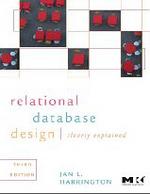

Дата отгрузки на данный момент неизвестна.
Товар закончился у основного поставщика, и, после получения заказа от вас, мы закажем его у других поставщиков. Мы не можем гарантировать выполнение данного заказа, поэтому настоятельно не рекомендуем заказывать данный товар, используя предоплату (банковский перевод и т.п.). Заказ на такой товар действителен в течение 3 недель (если в течение 3 недель товар не придет, заказ будет отменен). Однако, это не означает, что товар нельзя заказать вновь, поскольку в некоторых случаях возможны и более поздние поставки.
Технические характеристики
Fully revised, updated, and expanded, Relational Database Design and Implementation, Third Edition is the most lucid and effective introduction to the subject available for IT/IS professionals interested in honing their skills in database design, implementation, and administration. This book provides the conceptual and practical information necessary to develop a design and management scheme that ensures data accuracy and user satisfaction while optimizing performance, regardless of experience level or choice of DBMS.
The book begins by reviewing basic concepts of databases and database design, then briefly reviews the SQL one would use to create databases. Topics such as the relational data model, normalization, data entities and Codds Rules (and why they are important) are covered clearly and concisely but without resorting to "Dummies"-style talking down to the reader. Supporting the books step-by-step instruction are three NEW case studies illustrating database planning, analysis, design, and management practices. In addition to these real-world examples, which include object-relational design techniques, an entirely NEW section consisting of three chapters is devoted to database implementation and management issues.
* Principles needed to understand the basis of good relational database design and implementation practices.
* Examples to illustrate core concepts for enhanced comprehension and to put the books practical instruction to work.
* Methods for tailoring DB design to the environment in which the database will run and the uses to which it will be put.
* Design approaches that ensure data accuracy and consistency.
* Examples of how design can inhibit or boost database application performance.
* Object-relational design techniques, benefits, and examples.
* Instructions on how to choose and use a normalization technique.
* Guidelines for understanding and applying Codds rules.
* Tools to implement a relational design using SQL.
* Techniques for using CASE tools for database design.